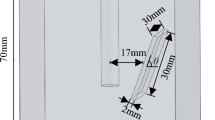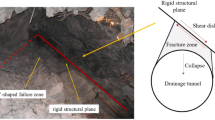Abstract
Rockbursts in underground mines can cause devastating damage to mine workings; hence, it is important to be able to assess the potential for their occurrence. The present study focuses on a large seismic event that took place at an underground base metal mine in Canada. The event took place in a dyke near the 100/900 orebodies on 3880 Level (1180 m below surface) of the Copper Cliff Mine in Sudbury, Canada. A 3D continuum stress analysis of the orebodies, i.e., 100 and 900, using an orebody-wide model encompassing the major geological structures and in situ stress heterogeneity in the mine shows low potential for rockburst at the seismic source location—a result which contradicts the fact that a large seismic event actually took place. A postulation is thus made that there had been highly stressed regions caused by geological disturbances at the source location before mining activities took place. In order to verify the postulation, a further study is undertaken with the discrete element modelling technique, whereby a cube-shaped model containing a fracture network is subjected to a stress state similar to that at the source location. A model parametrical study is conducted with respect to the distribution of the fracture (joint) network and its mechanical properties. The results reveal that when joints are densely distributed at the source location, the stress state becomes significantly burst prone. It is observed that the length, density, stiffness, and orientation of joints have a large influence on the stress state along the joints, while the friction angle, cohesion, and tensile strength do not influence the stress state. A cube-shaped model is constructed with joint sets actually mapped at the mine and a stress analysis is performed. The results demonstrate the generation of highly stressed regions due to the interaction of the joints with the applied in situ stress fields, thus leading to burst-prone conditions. The present study numerically confirms that a preexisting fracture network found within a stiff rockmass could lead to burst-prone stress state at relatively moderate mining depths.





















Similar content being viewed by others
References
Alber M, Fritschen R (2011) Rock mechanical analysis of a M1 = 4.0 seismic event induced by mining in the Saar District, Germany. Geophys J Int 186:359–372
Bandis S, Lumsden AC, Barton NR (1983) Fundamentals of rock joint deformation. Int J Rock Mech Min Sci Geomech 20(6):249–268
Barton N (1973) Review of a new shear-strength criterion for rock joints. Eng Geol 7:287–332
Barton N (2013) Shear strength criteria for rock, rock joints, rockfill and rock masses: problems and some solutions. J Rock Mech Geotech Eng 5:249–261
Barton N, Choubey V (1977) The shear strength of rock joints in theory and practice. Rock Mech 10:1–54
Bewick RP, Valley B, Runnals S, Whitney J, Krynicki Y (2009) Global approach to managing deep mining hazard. In: The 3rd CANUS rock mechanics symposium, Toronto
Bieniawski ZT (1976) Rock mass classification in rock engineering. In: Exploration for rock engineering. Balkema, Cape Town
Blake W, Hedley DGF (2003) Rockbursts case studies from North America Hard-Rock Mines. In: Society for mining, metallurgy, and exploration, Littleton, Colorado, USA
Castro LM, Bewick RP, Carter TG (2012) An overview of numerical modelling applied to deep mining. CRC Press/Taylor & Francis, London, pp 393–414
Diederichs MS (1999) Instability of hard rockmass: the role of tensile damage and relaxation. University of Waterloo, Waterloo
Diederichs MS, Kaiser PK, Eberhardt E (2004) Damage initiation and propagation in hard rock during tunnelling and the influence of near-face stress rotation. Int J Rock Mech Min Sci 41:785–812
Fisher NI (1996) Statistical analysis of circular data. Cambridge University Press, Cambridge
Hedley DGF (1992) Rockburst handbook for Ontario hard rock mines. Ontario Mining Association, North York
Herget G (1987) Stress assumptions for underground excavations in the Canadian Shield. Int J Rock Mech Min Sci Geomech Abstr 24(1):95–97
Heunis R (1980) The development of rock-burst control strategies for South African gold mines. S Afr Inst Min Metall 80(4):139–150
Hoek E, Bieniawski ZT (1965) Brittle fracture propagation in rock under compression. Int J Fract Mech 1(3):137–155
Hoek E, Brown ET (1997) Practical estimates of rock mass strength. Int J Rock Mech Min Sci 34(8):1165–1186
Hoek E, Martin CD (2014) Fracture initiation and propagation in intact rock—a review. J Rock Mech Geotech Eng 6:287–300
Hooker JN, Laubach SE, Marrett R (2014) A universal power-law scaling exponent for fracture apertures in sandstones. Geol Soc Am Bull 127(3–4):516–538
Itasca (2009) FLAC3D—fast Lagrangian analysis of continua. Itasca Consulting Group Inc., USA
Itasca (2014) 3DEC—3 dimensional distinct element code, version 5.0. ICG, Minneapolis
Kidybinski A (1981) Bursting liability indices of coal. J Rock Mech Min Sci 18(4):295–304
Ledwada LS, Scheepers J, Durrheim RJ (2012) Rockburst damage mechanism at Impala platinum. In: Southern hemisphere international rock mechanics symposium SHIRMS 2012, pp 367–386
Martin CD, Kaiser PK (1999) Predicting the depth of stress induced failure around underground excavations in brittle rocks. In: 49th Canadian geotechnical conference St. John’s, Newfoundland, pp 105–114
McGarr A, Spottiswoode SM, Gay NC (1975) Relationship of mine tremors to induced stresses and to rock properties in the focal region. Bull Seismol Soc Am 65(4):981–993
Mitri HS, Edrissi R, Henning J (1994) Finite element modelling of cable-bolted stopes in hardrock ground mines. In: SME Annual Meeting, Albuquerque, New Mexico, pp 94–116
Mitri HS, Tang B, Simon R (1999) FE modelling of mining-induced energy release and storage rates. J S Afr Inst Min Metall 99(2):103–110
Ortega OJ, Marrett RA, Laubach SE (2010) A scale-independent approach to fracture intensity and average spacing measurement. Am Assoc Petrol Geol 90(2):193–208
Ortlepp WD, Stacey TR (1994) Rockburst mechanisms in tunnels and shafts. Tunn Undergr Space Technol 9:59–65
Pola A, Crosta GB, Fusi N, Castellanza R (2014) General characterization of the mechanical behaviour of different volcanic rocks with respect to alteratino. Eng Geol 169:1–13
Qiu S, Feng X, Zhang C, Xiang T (2014) Estimation of rockburst wall-rock velocity invoked by slab flexure sources in deep tunnels. Can Geotech J 51:520–539
Sainoki A, Mitri HS (2014) Methodology for the interpretaiton of fault-slip seismicity in a weak shear zone. J Appl Geophys 110:126–134. doi:10.1016/j.jappgeo.2014.09.007
Shnorhokian S, Mitri HS, Thibodeau D (2014) Numerical simulation of pre-mining stress field in a heterogeneous rockmass. Int J Rock Mech Min Sci 66:13–18
Wawersik WK, Fairhurst CA (1970) A study of brittle rock fracture in laboratory compression experiments. Int J Rock Mech Min Sci Geomech 7:561–575
Acknowledgments
This work is financially supported by a grant by the Natural Science and Engineering Research Council of Canada (NSERC) in partnership with Vale Canada Ltd—Ontario Operations under the Collaborative Research and Development Program. The authors are grateful for their support.
Author information
Authors and Affiliations
Corresponding author
Rights and permissions
About this article
Cite this article
Sainoki, A., Mitri, H.S., Yao, M. et al. Discontinuum Modelling Approach for Stress Analysis at a Seismic Source: Case Study. Rock Mech Rock Eng 49, 4749–4765 (2016). https://doi.org/10.1007/s00603-016-1089-7
Received:
Accepted:
Published:
Issue Date:
DOI: https://doi.org/10.1007/s00603-016-1089-7




